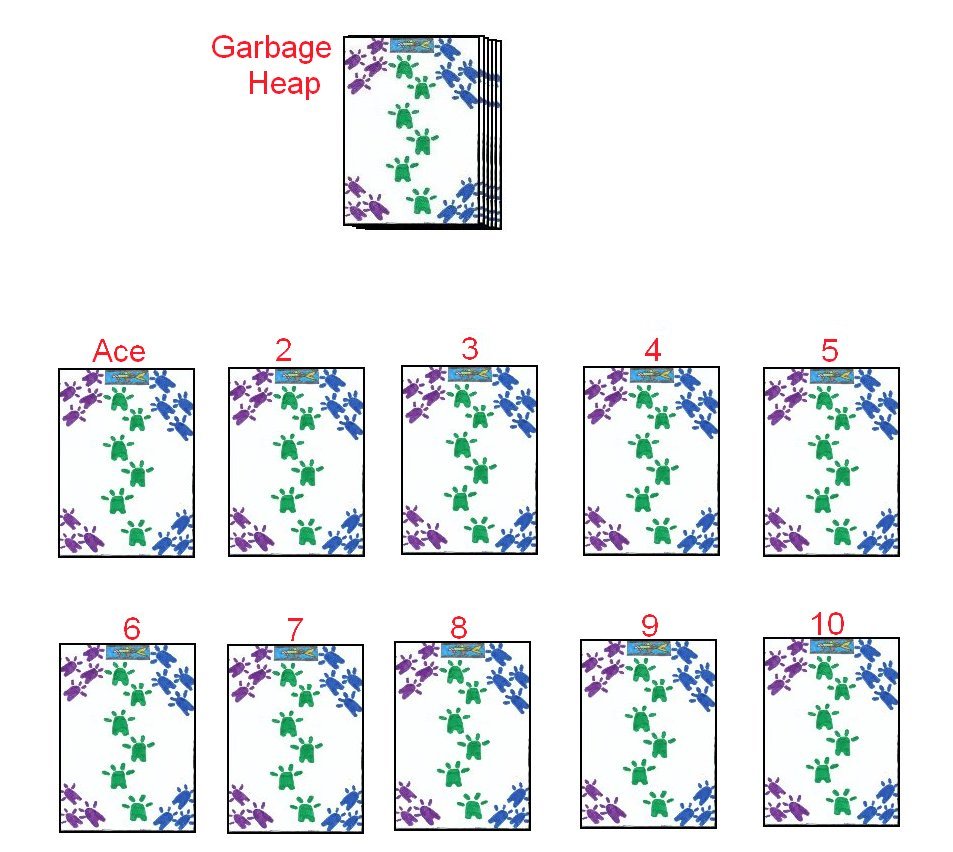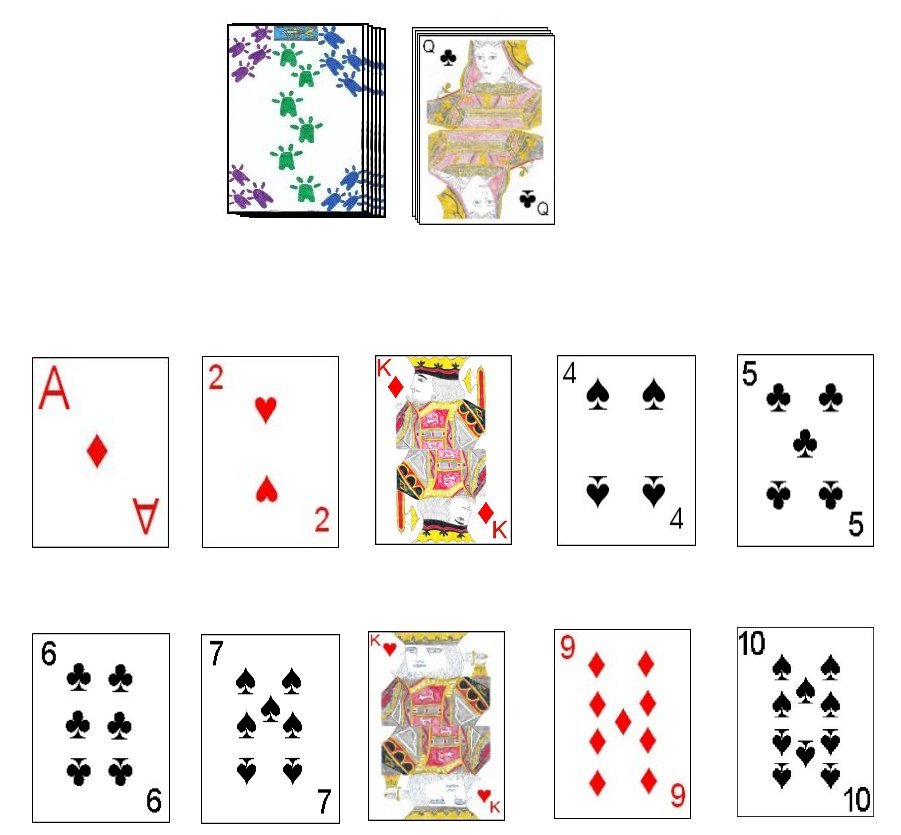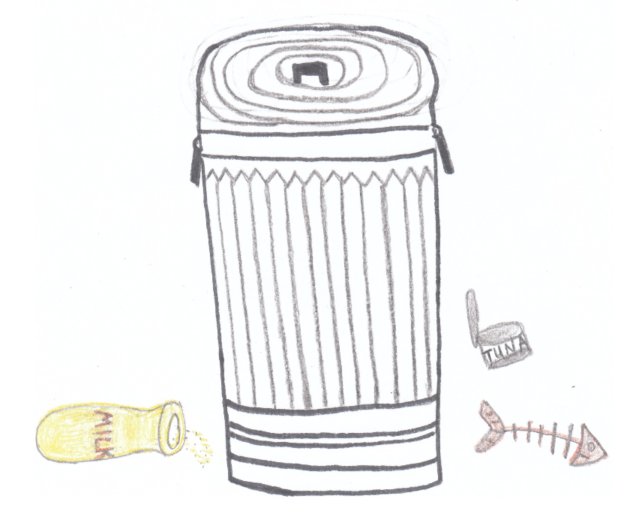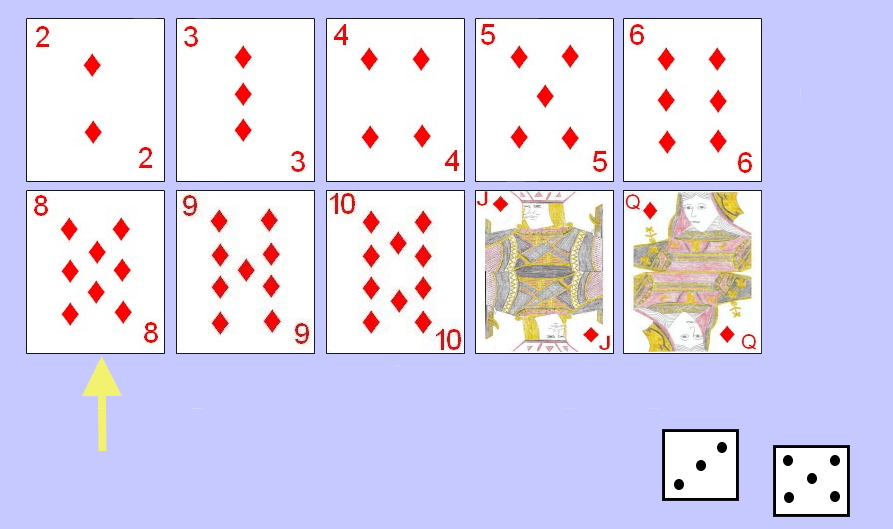 |
| Each card in a player's layout can be replaced with a specific denomination card from the deck, from Ace through Ten. |
Trash, also called Garbage is an entertaining and easy game to learn and play. The object is to be the first to completely clear his card layout.
The card game Trash can be played by 2 or more players. For two players one standard 52 card deck is used, and for 3 or 4 two such standard decks would be shuffled together and used. For 5 or more, 3 decks would be used. In this game, there is no specific concept of card ranking, although the card denominations do have a positional equivalent on each player's card layout. Also, the different suits have no bearing on the play. After the deal, the remaining cards would be placed in a face down stock in the center of the table as the draw pile or garbage heap.
To begin, each player is dealt one face-down card at a time in a clockwise rotation starting at the player to the immediate right of the dealer. This continues until each player has a total of 10 cards.
As the players receive their cards, they should place them in a specific layout on the table in front of themselves. This can either be one long row of 10 cards or two rows of 5 cards each. Each of these cards is represented by a specific numbered card in the deck. The first card in the layout would be represented by an Ace, the next by a Deuce (two) and so on, in an ascending sequence all the way to the last card in their layout which would be equivalent to a ten. The significance of this configuration will be seen shortly.
After all cards are dealt and arranged by the players, the player to the dealer's immediate left takes the first turn. He begins by drawing the top card of the stock. If this card is an Ace through Ten, he replaces the face down card in that corresponding position in his layout with this card. He would then turn over the card being replaced in his layout. If this card can also replace a face-down card in his layout, he replaces that card with the one just exposed. He can continue in this way until the exposed card is either a number that has already been replaced or he draws a Jack or Queen. If a King is exposed during play, this is a wild card and may be used to replace any remaining face down card on a player's layout. If a player draws the card that corresponds to the position of a wild card on his own layout, he may replace the wild card with the correct number and use the wild card somewhere else on his layout.
Once the player is unable to make further plays, he then places the last exposed card (that he was unable to use) next to the stock pile as a discard pile, ending his turn.
The next player in a clockwise rotation then has his own turn. He plays in a similar manner to the dealer, with one difference. Instead of taking the top card of the stock, he also has the option to take the top card of the discard pile (the last player's discard) instead, if it corresponds to a face down card on his own layout.
The game continues in this way until one player, during his turn, manages to expose every card in his layout. This player then wins that round. However, after a player wins the round, each other player has one more turn in which to try to fill their own layout.

After a player wins the hand, the cards are all gathered, reshuffled and dealt again by the next dealer in turn. However, the player who won the last round (as well as any other players who were able to clear their layout during the last turn of that round) is dealt one fewer cards than they had on the last round. All other players receive the same number of cards as they had on the last round.
Because a player is dealt one fewer card on the next round after successfully clearing his layout, the player thus needs to clear a smaller layout (i.e. after clearing a ten card layout, on the next round the player receives only nine cards). A player wins the game when he is down to a layout of one card and he is able to expose that card by drawing an Ace or wild card (King) during the hand before another player wins the round instead.
There are several variant rules that are sometimes used when playing this game, including the following:
 Jokers:
Jokers: Some players prefer to add two Jokers to each deck used in this game. When added, a Joker has the same affect as a King. It is a wild card and can be used to replace any non-exposed card in the player's layout.
Eight Card Hands: Another variant has the players starting with eight card layouts instead of the usual ten.
These eight cards are usually dealt in two rows of four cards each for
each player. Using this smaller layout usually makes for a somewhat shorter game.
Seven Up: Seven Up is another card game which has the same concept as does Trash. In this variant, each player is dealt one face-down row of seven cards with the remainder of the deck placed in a face-down pile as the stock. This game should not be confused with the Trick taking game from the All-Fours family which also goes by several names, including Seven Up.
As in the standard game as described above, players start the turn by drawing a card from the draw pile and if that card is an Ace, 2, 3, 4, 5, 6 or 7 and the card in that same ordinal position has not already been replace with the appropriate number, the player may so place that card in that position, uncovering the face-down card that was previously in that position. If the replaced card can also be used similarly in that same persons layout he may also play that card, continuing until drawing a card of a rank that has already been replaced or drawing a card of rank 8, 9, 10, Jack, Queen or King which are unplayable. When drawing such an
unplayable card, the player places the card in the discard pile an ends his turn. Each player
always begins his turn by drawing the top card of the draw pile, with players non permitted to draw the top card from the
discard pile. As in the standard game of Trash, the first player to reveal all face-down cards in his layout through legal players is declared the winner.
 Help Your Neighbor:
Help Your Neighbor: Help your Neighbor is a game with a layout
similar to Trash and with the same ultimate goal, however the method of play
is significantly different. In this variant, players roll dice instead
of drawing cards to determine choice of cards to be manipulated in the
layout. Before play begins each player should be given one card in each
of the following denominations from the deck: 2, 3, 4, 5, 6, 8, 9, 10,
Jack, and Queen. In addition one pair of standard dice is necessary for
play of Help Your Neighbor. This game can be played by anywhere from three to eight players and is usually best for four or five.
To start each player should place, in a layout in front of himself, the eight cards he was provided at the start of the game, in two rows, the first row consisting of the cards 2, 3, 4, 5, and 6 and the second row the cards of denomination 8, 9, 10, Jack, and Queen. Each card in the layout represents a specific total that might occur from the roll of the two die, with the Jack equating to 11 and the Queen 12. It is not strictly required to use standard playing cards to create this layout and players could instead use any other appropriate marker, such as writing the numbers 2, 3, 4, 5, 6, 8, 9, 10, 11, and 12 on ten slips of paper for each active player.
To start play, one player should randomly selected to play first. This can be chosen by having all the players roll the dice and the player rolling the highest set to have the first turn.
On a turn, a player would thus roll the dice. The sum of the two
numbers on the dice indicate a specific rank of card which a player may
cover from his layout. He covers the card by simply turning it face-down so the rank of the card can no longer be seen,
but only the back-side of the card. If this player rolls a total for
which he has already shows on his layout, the privilege of covering the
specific number as rolled, passes to the next player in a clockwise
direction around the table. If that player also already has the card
representing that total turned over, this privilege continues around the
table until a player is able to use that number, thus covering his card
of that number. If no other players are able to use that number, the
turn comes back to the original player to have rolled the dice, who may
then roll again in an attempt to cover another card from his layout. In addition, if the player rolls a number he can use (and thus
covers that card), he may take another turn, rolling again. However, if
the player was not able to use the number rolled, but another player, in
turn, was thus able, the turn immediately moves to that player, who then
has his turn, after covering the card corresponding to the initially rolled number.
If a player rolls a seven, however, he must uncover (flipping the card
back over, exposing it's face) an already previously covered card from
his layout (of his choice) and end his turn. The turn then moves to the
next player in a clockwise direction. If the player has no cards as of
yet turned over in his layout, he simply misses his turn and the turn passes to the next player in a clockwise direction.
The winner of the game is the first player to manage to cover all cards from his layout.
Help Your Neighbor (Cards in Hand variant): Another less common, but
equally as fun, variant of Help your Neighbor is also sometimes played. This variant is played similarly to the standard variant described above. However, there are several differences that make it a distinct game as well:
- The game can be played by from 2 to 8 players. For 2, 3 or 4 players one standard deck should be used and for 5, 6,
7 or 8 players, two decks are used. As in the standard game all Aces, sevens and Kings are removed from the deck to be used for play, and set aside. Since each player should receive an equal number of cards in the deal, additional cards may need to be also removed from the deck and set aside to ensure this. It is usually preferable to start by removing the highest and lowest ranked cards first (such as Queens and twos).
- The entire deck is dealt out, such that each player receives an equal number of cards. These cards are not, however, as in the standard game added to a center layout, but rather taken into the hand, only seen by the player to whom they were dealt to.
- On a player's turn he first rolls the dice. If the player then has a card corresponding to the total number rolled on the two dice (with Jack equal to 11 and Queen 12), the player may play this card face-up from his hand to the center of the table in a play pile.
- If the player does not have a card equal to the number rolled on the dice, he simply passes the dice to the next player. However, if the next player has two or more cards in hand and has a card matching the number rolled by that previous player, he may thus play that card to the center of the table. After playing this card, this player then rolls the dice for his turn as normal.
- If the player instead rolls a seven, he immediately ends his turn, passing the dice to the next player in rotation.
- Whichever player first manages to play his last card to the table is declared the game winner.
Copyright © 2015 CatsAtCards.com. All rights reserved.

 After a player wins the hand, the cards are all gathered, reshuffled and dealt again by the next dealer in turn. However, the player who won the last round (as well as any other players who were able to clear their layout during the last turn of that round) is dealt one fewer cards than they had on the last round. All other players receive the same number of cards as they had on the last round.
After a player wins the hand, the cards are all gathered, reshuffled and dealt again by the next dealer in turn. However, the player who won the last round (as well as any other players who were able to clear their layout during the last turn of that round) is dealt one fewer cards than they had on the last round. All other players receive the same number of cards as they had on the last round.

